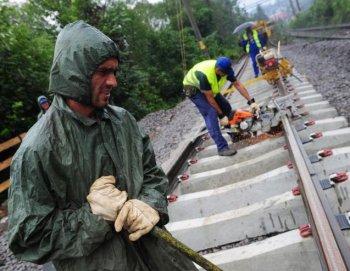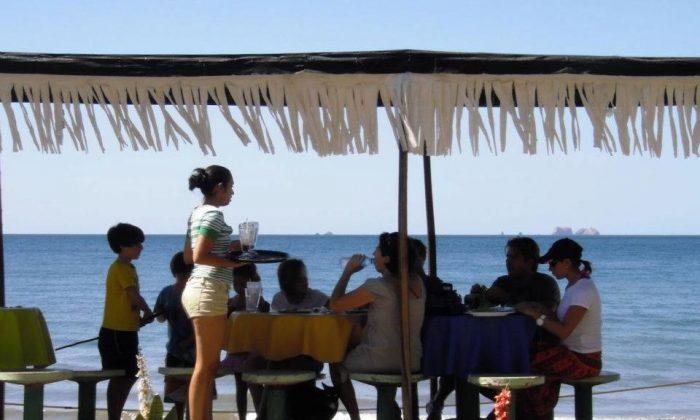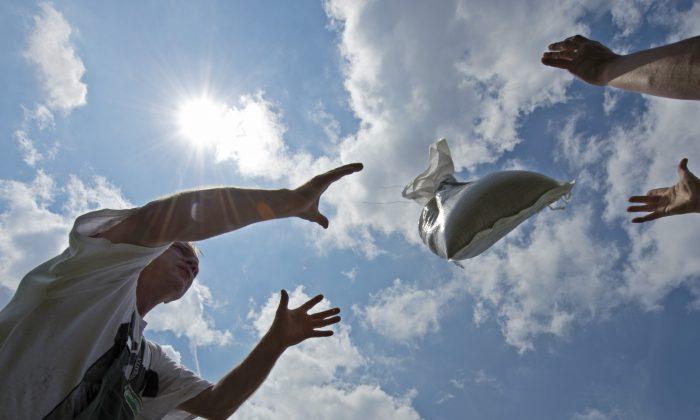MUNICH—Last week the European Bank for Reconstruction and Development (EBRD) published a quarterly economic forecast for the 30 Eastern European and Central Asian countries, describing post crisis challenges and the future outlook for the rest of 2010 and 2011.
Since the last quarterly forecast published in May, EBRD has reduced the 2010 forecast from a 3.7 percent to a 3.5 percent growth and in 2011 a slight reduction from a 4.0 percent to a 3.9 percent growth for the region. The lowering of the forecast is mainly attributed to high market volatility and strict austerity programs implemented by the governments in the region that could dampen economic development.
“Central and Eastern European countries depend heavily on trade and financial links with the EU. Given the weakening outlook for the eurozone—as fiscal austerity programs are implemented and financial markets are likely to remain volatile—the external environment may be less benign than previously projected,” said the forecast report.
“Credit growth is expected to remain weak as long as banks’ [EBRD] balance sheets remain under pressure and the cost of capital elevated.”
“The region is also facing heightened external risks arising from financial market volatility and the impact of fiscal tightening”.
The EBRD was created in 1991 to monitor and help former communist countries to undergo transition from closed state controlled economies to open market economies. It includes countries such as Russia, Kazakhstan, Poland, Slovenia, Lithuania, Mongolia, and 24 others.
As part of help offered, the bank is investing in private enterprises in order to stimulate the growth of local economies. Additionally, it persuades other commercial banks such as Italy’s UniCredit SpA, France’s Societe Generale SA, and Austria’s Erste Bank AG to take part in investment by providing these banks suitable funds to lend to local businesses.
Central Europe and Baltic Countries
For 2010 the forecast for Central Europe and Baltic countries is to grow 1.7 percent and for 2011 the growth will be 3.1 percent.
Poland is seen as the leader economy, growing “2.7 percent this year, which is strong by regional standards.”
The Slovak Republic is benefiting from “recovery in European industrial production, in particular of cars.” It is set to grow 3.1 percent in this year and 3.4 percent in the next.
Southeastern European Countries and Turkey
In most of the Southeastern European countries there is virtually not much sign of economic growth except for Turkey, which is growing at an astounding rate.
Turkey shows a robust growth of 5.9 percent this year and 4.0 percent in 2011. “Capital inflows, especially portfolio flows, have increased rapidly and unemployment continues to decline as employment rises.”
The only two countries with negative growth in this group are Bulgaria and Romania. In the latter, the austerity program is slowing down the economy, as the government promised to cut public sector wages by 25 percent and increase VAT by 5 percent, which “will further dampen domestic demand in the short term.”
“Growth in Bulgaria is constrained by the need to improve competitiveness, maintain fiscal discipline, and cope with the slowdown in foreign direct investment inflows that were a key growth driver per-crisis.”
Eastern Europe and the Caucasus
“This diverse group of countries has benefited from recent improvement of market confidence in emerging markets and higher commodity prices,” the report said.
After a disastrous drop of 15 percent of Ukraine’s GDP in 2009, it is set to a steady 4 percent growth for the next 2 years. The new Russian-inclined president Viktor Yanukovych is setting a trend of confidence to put the damaged economy back on its feet and IMF has agreed to lend $14.5 billion to aid the recovery.
Georgia sees a positive 3.5 percent growth this year and 4.5 percent in 2011. “Economic vulnerabilities in Georgia (including a large trade deficit) continue to be partially mitigated by a generous aid package from a wide range of donors, which has partly compensated for the collapse of foreign direct investment,” the report said.
Russia, Central Asia, and Mongolia
According to the report, “Both the Russian and the Kazakh economies have been on a steep recovery path since the end of 2009, on the back of higher oil prices, large-scale fiscal stimulus packages, and banking-system support.”
Russia, which shrunk a miserable negative 7.8 percent in 2009, is seeing a stable growth of 4.4 percent this year and another 4.6 percent in 2011.
Kazakhstan is set on a fast recovery of 4.0 percent this year and 5.3 percent in the next. “Industrial production and manufacturing grew by 11 percent and 18 percent in the first half of 2010, respectively, mainly driven by an increased extraction of coal, oil, copper, and other minerals.”
Turkmenistan is the impressive winner of all 30 countries, growing 11 percent in 2010 and another 12 percent in 2011. This is mainly due to “higher export volumes [of gas] to China and Iran, which is supporting growth.”
The politically troubled Kirgiz Republic is feeling the negative effects of the violent riots, as the economy is set to shrink 3.7 percent this year. In 2011, it is set to growth an impressive 7.0 percent only if the country manages to maintain a peaceful state.
Since the last quarterly forecast published in May, EBRD has reduced the 2010 forecast from a 3.7 percent to a 3.5 percent growth and in 2011 a slight reduction from a 4.0 percent to a 3.9 percent growth for the region. The lowering of the forecast is mainly attributed to high market volatility and strict austerity programs implemented by the governments in the region that could dampen economic development.
“Central and Eastern European countries depend heavily on trade and financial links with the EU. Given the weakening outlook for the eurozone—as fiscal austerity programs are implemented and financial markets are likely to remain volatile—the external environment may be less benign than previously projected,” said the forecast report.
“Credit growth is expected to remain weak as long as banks’ [EBRD] balance sheets remain under pressure and the cost of capital elevated.”
“The region is also facing heightened external risks arising from financial market volatility and the impact of fiscal tightening”.
The EBRD was created in 1991 to monitor and help former communist countries to undergo transition from closed state controlled economies to open market economies. It includes countries such as Russia, Kazakhstan, Poland, Slovenia, Lithuania, Mongolia, and 24 others.
As part of help offered, the bank is investing in private enterprises in order to stimulate the growth of local economies. Additionally, it persuades other commercial banks such as Italy’s UniCredit SpA, France’s Societe Generale SA, and Austria’s Erste Bank AG to take part in investment by providing these banks suitable funds to lend to local businesses.
Central Europe and Baltic Countries
For 2010 the forecast for Central Europe and Baltic countries is to grow 1.7 percent and for 2011 the growth will be 3.1 percent.
Poland is seen as the leader economy, growing “2.7 percent this year, which is strong by regional standards.”
The Slovak Republic is benefiting from “recovery in European industrial production, in particular of cars.” It is set to grow 3.1 percent in this year and 3.4 percent in the next.
Southeastern European Countries and Turkey
In most of the Southeastern European countries there is virtually not much sign of economic growth except for Turkey, which is growing at an astounding rate.
Turkey shows a robust growth of 5.9 percent this year and 4.0 percent in 2011. “Capital inflows, especially portfolio flows, have increased rapidly and unemployment continues to decline as employment rises.”
The only two countries with negative growth in this group are Bulgaria and Romania. In the latter, the austerity program is slowing down the economy, as the government promised to cut public sector wages by 25 percent and increase VAT by 5 percent, which “will further dampen domestic demand in the short term.”
“Growth in Bulgaria is constrained by the need to improve competitiveness, maintain fiscal discipline, and cope with the slowdown in foreign direct investment inflows that were a key growth driver per-crisis.”
Eastern Europe and the Caucasus
“This diverse group of countries has benefited from recent improvement of market confidence in emerging markets and higher commodity prices,” the report said.
After a disastrous drop of 15 percent of Ukraine’s GDP in 2009, it is set to a steady 4 percent growth for the next 2 years. The new Russian-inclined president Viktor Yanukovych is setting a trend of confidence to put the damaged economy back on its feet and IMF has agreed to lend $14.5 billion to aid the recovery.
Georgia sees a positive 3.5 percent growth this year and 4.5 percent in 2011. “Economic vulnerabilities in Georgia (including a large trade deficit) continue to be partially mitigated by a generous aid package from a wide range of donors, which has partly compensated for the collapse of foreign direct investment,” the report said.
Russia, Central Asia, and Mongolia
According to the report, “Both the Russian and the Kazakh economies have been on a steep recovery path since the end of 2009, on the back of higher oil prices, large-scale fiscal stimulus packages, and banking-system support.”
Russia, which shrunk a miserable negative 7.8 percent in 2009, is seeing a stable growth of 4.4 percent this year and another 4.6 percent in 2011.
Kazakhstan is set on a fast recovery of 4.0 percent this year and 5.3 percent in the next. “Industrial production and manufacturing grew by 11 percent and 18 percent in the first half of 2010, respectively, mainly driven by an increased extraction of coal, oil, copper, and other minerals.”
Turkmenistan is the impressive winner of all 30 countries, growing 11 percent in 2010 and another 12 percent in 2011. This is mainly due to “higher export volumes [of gas] to China and Iran, which is supporting growth.”
The politically troubled Kirgiz Republic is feeling the negative effects of the violent riots, as the economy is set to shrink 3.7 percent this year. In 2011, it is set to growth an impressive 7.0 percent only if the country manages to maintain a peaceful state.






